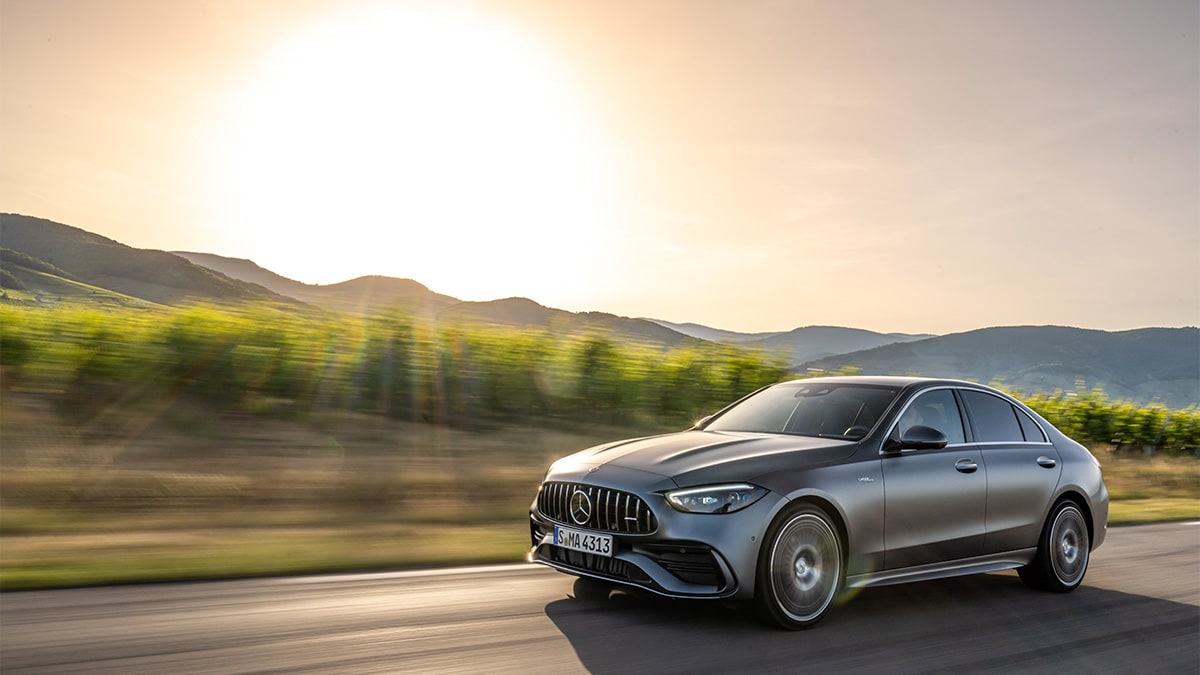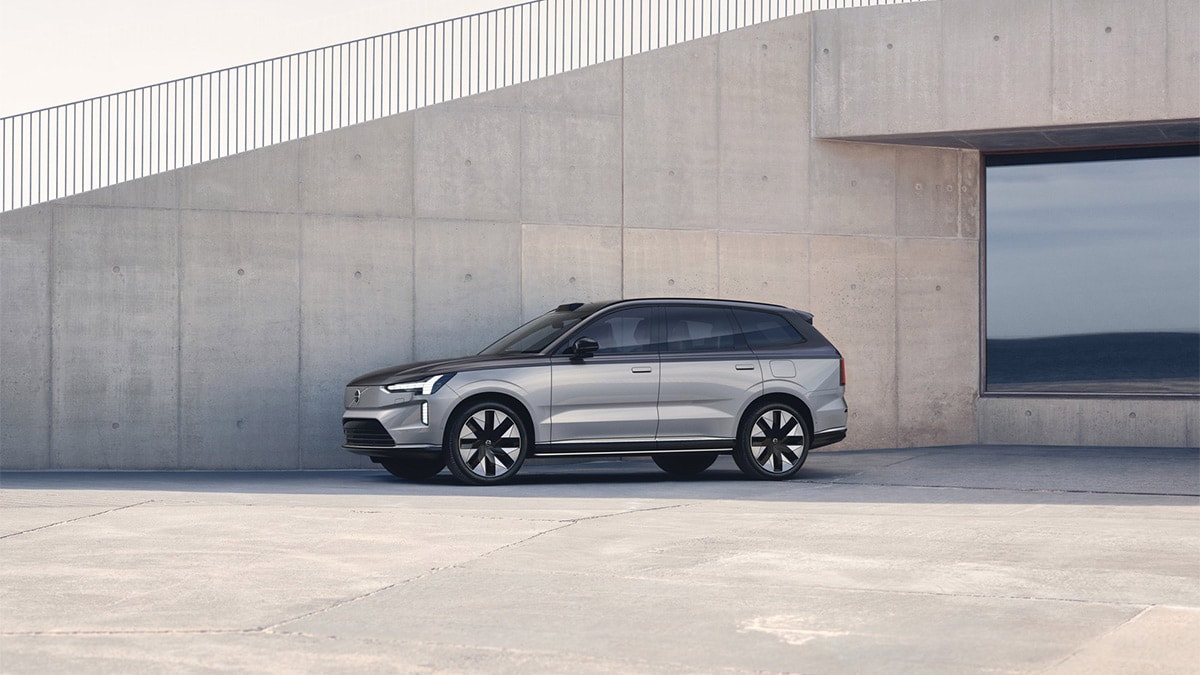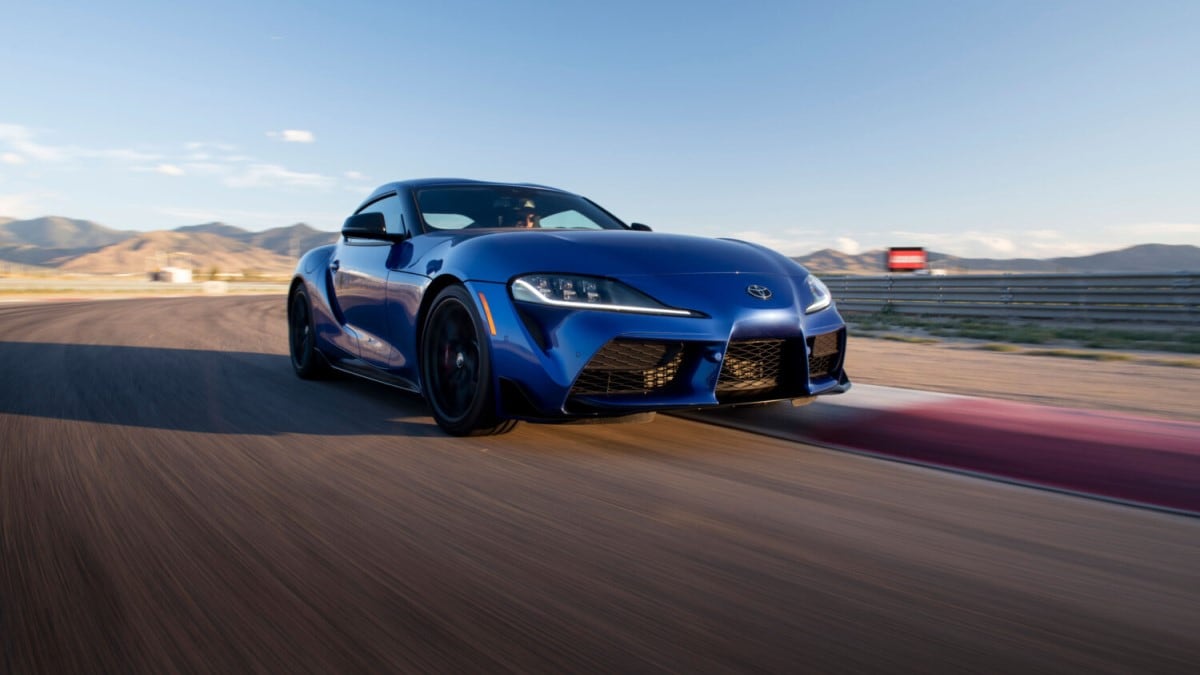- Our methodology for selecting the safest cars starts with the pool of those with perfect crash-test scores.
- Then, we determined the safest trim levels based on advanced driver assistance features.
- In addition to telling you about the safest models, we list the second tier of safe cars with the IIHS Top Safety Pick recognition.
Why publish a list of our picks for the best new cars that are the safest? Aren’t all cars safe in 2024? Don’t confuse “safe” with “safer.”
Manufacturers make vehicles safer than those from 10 years ago, for sure. However, some are safer than others. At least, that’s the finding of the Insurance Institute for Highway Safety (IIHS) and the United States government’s National Highway Traffic Safety Administration (NHTSA).
Both organizations put new car models through a battery of crash and safety tests, scoring each for the degree of protection they provide for occupants.
If you choose a car on this list, you can be assured you will be more likely to survive a crash and possibly avoid it altogether. We pulled together a collection of the best 2024 models that make it safer for you to drive on the road and what earns them that distinction.
In a nutshell, these car models go above and beyond government-mandated safety features and manufacturer norms. Read on to learn more. Use the following jump links to skip ahead in the story.
How We Did It: The Methodology
We looked for cars with top scores in both IIHS and NHTSA testing. With those in hand, we narrowed the field among the trim levels within each model based on standard and available active safety features such as forward collision warning with automatic emergency braking.
Several safety features to which we’ve grown accustomed are actually government-mandated. In other words, the federal government made them standard by law. These include antilock brakes, stability control, traction control, rearview cameras, tire pressure monitors, etc.
Airbags
The government also mandates airbags. However, that mandate stops at two: one for the driver and one for the front passenger. Besides 2-seat sports cars, nearly all passenger vehicles today come with at least six airbags. They include the two mandated airbags, two front-side impact airbags, and two side-curtain airbags.
However, several models don’t stop there, either. They may include airbags covering rear-side impact, knee, front center, etc. We point out when one of our picks provides more than six airbags.
Some government-mandated safety features are referred to as active safety features, defined by their role in preventing accidents. Stability control and antilock brakes fall into this category. Because we know these are mandated features, we don’t itemize them in our descriptions.
Advanced Driver Assistance Technologies
We are convinced that advanced driver assistance systems (ADAS) are critical to your and your family’s safety when in your car. In research published in August 2023, AAA reported that 37 million crashes could be prevented over the next 30 years with the widespread adoption of ADAS. Moreover, preventing those millions of crashes could save 250,000 lives while preventing 14 million injuries. Consequently, ADAS ranks high in our consideration when picking our list of safest cars.
In determining the safest trim levels within models, we looked at active safety features that the government does not mandate. This is where features like forward collision warning, blind-spot monitoring, automatic emergency braking, and lane-keeping assist come in.
We also considered other driver aids, such as adaptive cruise control, high-beam assist, driver-awareness alert, and a head-up display. We argue that LED exterior headlights, rain-sensing wipers, and auto-dimming rearview mirrors also contribute to a vehicle’s safety.
Here’s a list of the more significant advanced technologies we considered. Many carmakers have unique names for the advanced safety technologies listed below. We’ve used popular industry jargon. Moreover, we use the acronyms (in parentheses) in the safest cars’ descriptions for brevity.
- Adaptive Cruise Control (ACC): Adaptive cruise control maintains the preset speed you’ve chosen and also responds to the changing speed of the vehicle ahead. It slows your car as the vehicle ahead slows, then speeds back up as the other does. Some systems will bring the vehicle to a complete stop if necessary. A form of adaptive cruise control, Traffic Jam Assist, is engineered specifically for slow-moving stop-and-go city traffic.
- Adaptive Front Lights: These headlights turn in the same direction as the front wheels to light the way when taking a curve or making a turn.
- Automatic Emergency Braking (AEB): Often paired with forward collision warning, AEB senses when your vehicle is likely to strike an object in front of it. The AEB system then automatically applies the brakes. More sophisticated systems include pedestrian and cyclist detection. IIHS requires automatic emergency braking for TSP or TSP+ qualification. By 2029, automatic emergency braking will be in every new vehicle as required by federal mandate.
- Blind-Spot Monitoring (BSM): Sensors mounted on the corners of the rear bumper detect and warn of approaching traffic pulling into the blind spots on the rear quarters of your vehicle. Typically, it is married to the rear cross-traffic alert that warns of traffic crossing behind you when backing out of a parking space.
- Driver Monitoring System (DMS): Employing cameras and other sensors, DMS determines if a driver’s attention is still on the road. Several manufacturers call this technology “Driver Awareness Alert.”
- Forward Collision Warning: FCW uses a camera or a combination of camera and radar and sounds an audible alert when it detects an impending front crash. Many systems also include emergency braking if the driver fails to respond to the warning.
- High-Beam Assist: In vehicles with this system, the high beams remain on. The system automatically switches off the high beams when photosensors or a forward-pointed camera detects oncoming headlights or taillights. It automatically switches them back on when no vehicle lights are detected.
- Junction-Turning Assist (JTA): Sometimes called “intersection-turning assist,” this system detects oncoming traffic when making a left turn in an intersection. It sounds a warning, and some more advanced systems also engage the brakes.
- Lane Centering Assist (LCA): Using a forward-pointed camera, LCA keeps the vehicle centered in the lane by tracking lane markings. It’s a proactive system that constantly makes minute steering corrections to maintain its position in the center of the lane.
- Lane-Departure Warning (LDW): A front-pointed camera monitors the defining lines on the pavement bordering your driving lane. When the system senses you are drifting over either line, an auditory warning sounds if you don’t engage a turn signal. More sophisticated systems with steering assist even nudge you back toward the center.
- Lane-Following Assist (LFA): When the lane markings aren’t clearly defined, your vehicle maintains the same course as the vehicle preceding it.
- Lane-Keeping Assist: LKA is similar to lane-departure systems with steering assist, except there is no auditory warning. Lane-keeping assist uses a forward-pointed camera to keep track of lane markings. It constantly initiates steering corrections, keeping you within the lane boundaries.
- Park Assist: Sensors on a car’s rear and/or front bumper sound an alarm when they detect a nearby object. More sophisticated systems also provide automatic braking.
- Parking Assistance: These systems vary in sophistication and what they can accomplish independently. However, they all assume some of the tasks of parking a car parallel or diagonally. Basic systems assume steering duties while the driver retains control of the brakes. The most sophisticated systems find an appropriate parking space and then complete the parking task without driver input.
- Rear Cross-Traffic Alert (RCTA): Uses rear-mounted sensors to detect traffic crossing behind your vehicle when backing out of a parking space or driveway.
- Safe Exit Assist (SEA): Radar-based, this technology detects traffic approaching from the rear in a neighboring lane and prevents the doors on that side of the vehicle from opening.
- Surround-View Camera: Sometimes called bird’s-eye view or 360-degree monitoring, this is a series of at least four cameras, each taking an image of a different side of the vehicle. The system then knits the four images together, creating an image encompassing a few feet around the car. A representation of the vehicle is dropped into the center of the image. This technology is helpful when maneuvering through tight spaces or parking.
- Traffic Jam Assist (TJA): This is a low-speed adaptive cruise control for managing stop-and-go traffic or heavy-highway congestion situations.
- Traffic Sign Recognition: TSR is capable of recognizing a variety of common road signs, and displays recognized signs on one of the vehicle’s display screens or the head-up display, if so equipped.
Other Safety Features
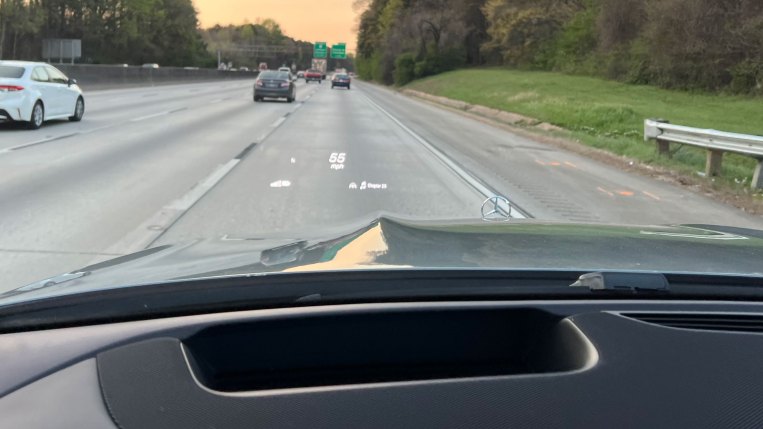
- Auto On-Off Headlights: Photosensors monitor daylight, automatically engaging the headlights as the daylight grows dim, then extinguishing them as daylight returns.
- Auto-Dimming Mirrors: Based on photosensors, they recognize bright headlights closing from behind, automatically dimming the reflection of those lights. Any of the rearview mirrors (inside and outboard) can have this feature.
- Head-up Display: A HUD projects key driver information onto the windshield just below the driver’s line of sight. The ability to check such information, for example, vehicle speed, keeps the driver’s eyes on the road versus glancing at the speedometer.
- Heated Outboard Mirrors: Electrically heated, these mirrors automatically clear the mirror surface of fog, ice, and snow. More sophisticated examples also include integrated turn signals.
- Hill-Start Assist: Sensors alert the system that your vehicle is stopped on an incline. The system then kicks in to retain full brake pressure as you transfer your foot from the brake pedal to the accelerator, preventing the vehicle from rolling.
- LED Headlights: Light-emitting diodes illuminate a broader and longer area than regular incandescent or halogen lights. This also means they are easier for other drivers to see.
- Rain-Sensing Wipers: This system automatically engages the wipers when it senses moisture on the windshield. The wiper speed adjusts to the volume of rain.
- Rear-Seat Alert: This feature automatically sounds an auditory reminder or flashes an alert to a driver exiting the vehicle to check the back seat for children, pets, and packages.
Vehicle Crash and Safety Testing
Here’s a crash course in crash tests and what you can expect.
IIHS
Key to our research and a core qualifier for our safest car picks is the battery of crash and safety tests performed by the independent and nonprofit Insurance Institute for Highway Safety. It relies on four main crash tests on cars, light trucks, minivans, and SUVs. They include a driver-side small overlap front, passenger-side overlap front, moderate overlap front, and side. It’s worth noting that the side-test protocol includes both the right and left sides; consequently, the side protocol could technically be called two tests for a total of five. However, the IIHS lumps the side tests into a single score for scoring purposes.
The IIHS no longer conducts a roof strength or head restraint test because the technology for both has become so advanced and good.
The IIHS scoring is Good, Acceptable, Marginal, and Poor in descending order. Every pick on our list scored Good for all four tests.
TIP: IIHS changed its side crash-test protocol in 2021, using a heavier ram. Although the results of this new version of the test were shown in some vehicles’ results in the past couple of years, 2023 was the first year the IIHS figured those results into a vehicle’s scoring. Consequently, testing and finalizing the 2024 scores has required extra time. This, combined with the initial difficulty of the IIHS and NHTSA acquiring vehicles for testing, has slowed the process considerably. In fact, the IIHS, in particular, has struggled to test vehicles fully using its new protocols. Consequently, there may be vehicles that will eventually qualify for our safest lists that currently don’t. Moreover, even for 2024, the IIHS is using a mix of old and new tests as qualifiers for TSP and TSP+.
Beyond the crash tests, the IIHS evaluates headlights and vehicle-to-pedestrian front crash protection. Here, the scoring is Superior, Advanced, and Basic. Moreover, the LATCH (Lower Anchors and Tethers for Children) child-seat anchors are also assessed.
Only models getting the highest marks in both the crash tests and the other evaluations earn the IIHS highest safety awards of Top Safety Pick (TSP) and Top Safety Pick+ (TSP+). Every model on our list has at least the IIHS TSP safety rating. When one of our picks is a TSP+, we mention it in the description. We do include a list of models earning the TSP safety rating.
Note: When the IIHS tests vehicles, it treats plug-in hybrids (PHEV) and electric vehicles (EV) as distinct models, scoring them separately from the ICE (internal combustion engine) models. However, IIHS views hybrid models that don’t require charging through an outside source as a trim level of the ICE model. That means if a gas-powered model made this list with a TSP or TSP+ rating, its hybrid version did, too.
NHTSA
The National Highway Traffic Safety Administration testing isn’t as involved as that of the IIHS. NHTSA performs front and side crash tests. The front test is a 35-mph crash into a fixed barrier. NHTSA combines the results of side-barrier and driver-door side-pole crash tests to arrive at the side test results. NHTSA scoring takes into account a rollover aspect in its scoring. It’s really an evaluation of the likelihood of a vehicle rolling over. No rollover crash test is performed.
NHTSA awards one to five stars each for front, side, and rollover scenarios. Five is the best score. NHTSA also issues an overall score. Every pick on this list boasts a 5-Star overall score. Where a 5-Star score isn’t the case, it’s because, for whatever reason, NHTSA hasn’t tested it. We’ve included them on this list because we don’t think we should omit them because of the lack of a NHTSA rating.
What Are the Safest Cars?
We’ve included the base price, the model nameplate with the price of what we consider the best value with the most safety, and the combined city/highway mileage for the base engine at the top of each description. You will also find our Kelley Blue Book Expert Rating. All pricing includes the inescapable factory-to-dealer delivery fee (destination charge).
Note: Even with dealer inventories improving for many car models, many popular models remain in short supply, with pricing constantly in flux. We aim to keep up with those price variations, updating stories with the latest price information as we discover it. However, these unannounced factory price hikes are difficult to track. In other words, the prices listed below are the most recent as of this writing. Moreover, you may still find dealer markups on some harder-to-find models from carmakers like Honda and Kia. Dealers add these charges to increase their profit on those models.
2024 Acura Integra
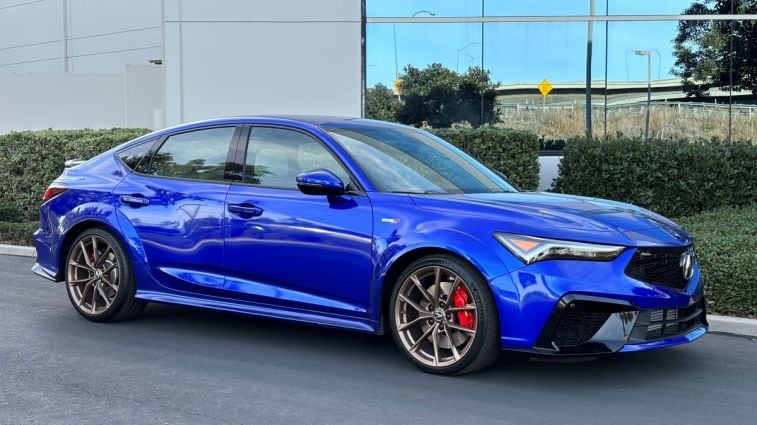
Best Safety Value: $33,595 (Integra)
Base Price: $33,595 | Expert Rating: 4.5
Combined Fuel Economy: 33 mpg
The Integra nameplate has only been back in showrooms since the 2022 calendar year. Not only is its name a historical throwback, but so is its very personality. It’s a luxury hatchback competing in a world of SUVs. If you don’t think that’s rare, how about Acura making a 6-speed manual transmission standard in the top A-Spec w/Technology Package trim? Built on the bones of the Honda Civic, even the Integra’s entry-level grade comes with AcuraWatch, the brand’s bundle of advanced safety tech. It includes automatic emergency braking, traffic sign recognition, traffic jam assist, adaptive cruise control, lane departure warning, lane-keeping assist, blind-spot monitoring, and rear cross-traffic alert. Our recommended safety features include 10 airbags, high-beam assist, hill-start assist, auto on-off LED headlights, and heated outboard mirrors. The Integra is an IIHS TSP+ winner.
You must move up two trim levels to the top grade to have any further impact on safety. With the A-Spec w/Technology Package trim ($38,595), you add front/rear park assist, low-speed rear automatic braking, rain-sensing wipers, a head-up display, and outboard mirrors with integrated turn signals. We’d save the $5,000 and stick with the base trim.
See Acura Integra models for sale near you
2024 BMW 5 Series
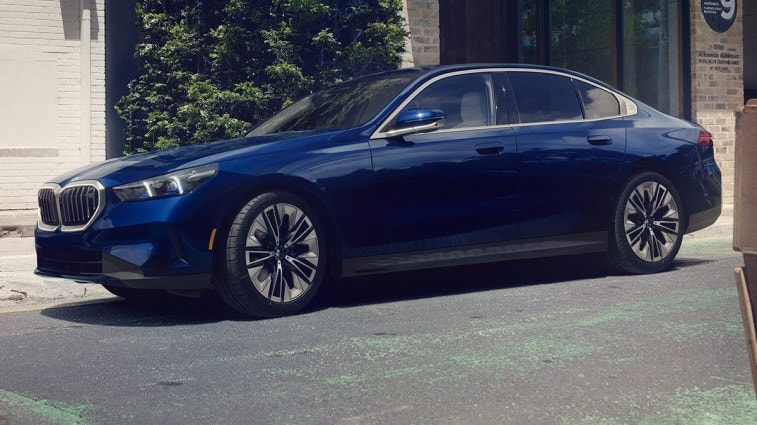
Best Safety Value: $63,945 (530i + Premium & Driving Assistance Pro Packages)
Base Price: $58,895 | Expert Rating: N/R
Combined Fuel Economy: 30 mpg
Completely redesigned for 2024, the 5 Series earned its spot in the IIHS TSP club. It’s a roomy midsize sedan that can gallop to 60 mph in just under 6.0 seconds. Its standard turbo 4-cylinder engine is aided by a mild-hybrid (MHEV) system. Among our recommended safety features in the entry-level 530i are automatic emergency braking, blind-spot monitoring, rear cross-traffic alert, lane departure warning, rain-sensing wipers, front/rear park assist, and high-beam assist.
For safety’s sake, we recommend opting for the Driving Assistance Professional Package, adding Active Driving Assistant Pro (evasive driving assist), adaptive cruise control, lane-keeping assist with steering assist, lane change assist with steering assist, and front/rear cross-traffic alert. This also requires the Premium Package with a head-up display, full LED headlights, and Parking Assistant Plus (self-parking system). These two option packages will add roughly $5,000 to the bottom line.
See BMW 5 Series models for sale near you
2024 Genesis Electrified G80
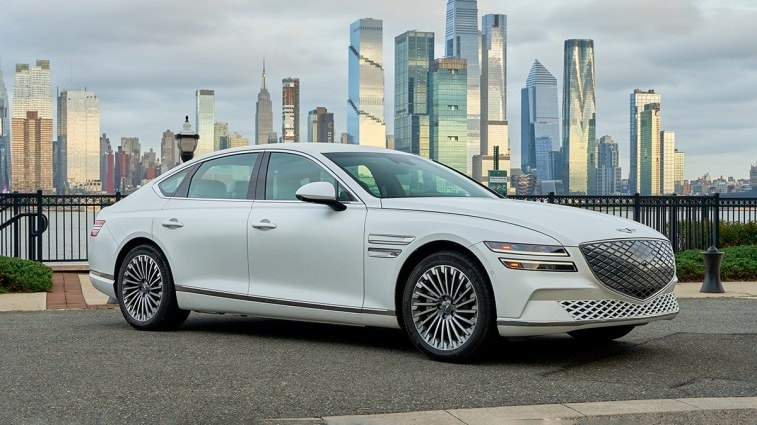
Best Safety Value: $75,625 (Advanced)
Base Price: $75,625 | Expert Rating: 4.3
Combined Fuel Economy: 97 MPGe
Available in 33 states nationwide, the all-wheel-drive (AWD) Electrified G80 was all-new in 2023. With an estimated range of up to 282 miles, this sedan balances luxury with fully electric performance. Charging time with a DC fast charger to bring the battery from 10% to 80% is about 22 minutes. The entry-level Advanced grade includes automatic emergency braking, lane-following assist, lane-keeping assist, driver monitoring system, blind-spot monitoring with steering assist, rear cross-traffic alert with automatic braking, park assist, and safe exit assist. A head-up display, rain-sensing wipers, LED headlights, and high-beam assist are standard, as well. It’s also a TSP+ pick.
Spending another $4,750 for the Prestige Package adds a surround-view camera, rear parking collision avoidance assist, a blind-spot view monitor, and Remote Smart Parking Assist that allows the driver to pull into or out of a tight parking space from outside the vehicle using a smartphone. When spending this much money on a car, we think spending another few grand to gain extra safety features (and other goodies like Nappa leather and a 12.3-inch 3D gauge cluster) makes some sense. However, listening to our more practical angel, we’d stick with the Advanced trim.
See Genesis Electrified G80 models for sale near you
2024 Genesis G80
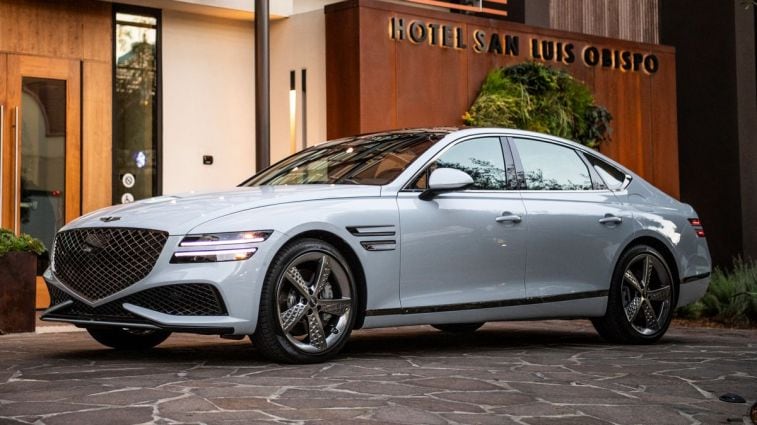
Best Safety Value: $55,650 (2.5T)
Base Price: $55,650 | Expert Rating: 4.3
Combined Fuel Economy: 25 mpg
An IIHS TSP+, the Genesis G80 is one of our favorite midsize luxury sedans. Its entry-level 2.5T Standard AWD trim runs on a 300-horsepower turbocharged 4-cylinder engine. At this price point, the interior trimmings are mostly plastic and faux leather, but the workmanship is meticulous. Of our recommended safety features, the G80 has automatic emergency braking, lane-following assist, lane-keeping assist, driver monitoring system, blind-spot monitoring with steering assist, rear cross-traffic alert with automatic braking, parking assist, high-beam assist, adaptive cruise control, and safe exit assist.
Ante up another $9,550 for the Sport Prestige Package to get a surround-view camera, a blind-spot view monitor, automatic reverse braking, and Remote Smart Parking Assist that allows you to finish parking the G80 from outside the car. We’d save the extra thousands and stick with the 2.5T grade.
See Genesis G80 models for sale near you
2024 Genesis G90
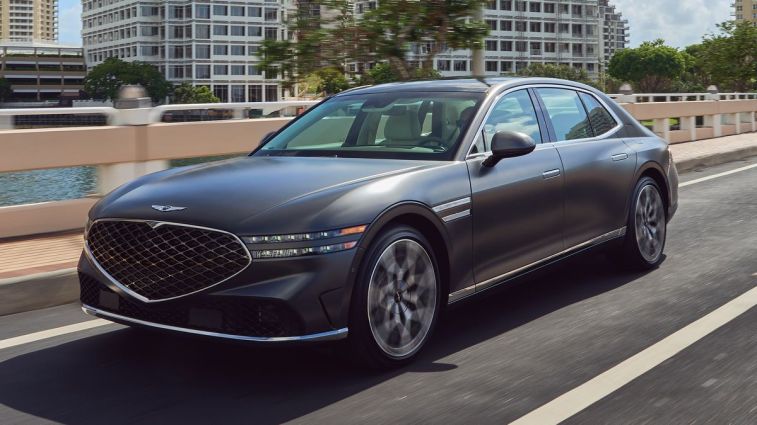
Best Safety Value: $90,450 (3.5T)
Base Price: $90,450 | Expert Rating: 4.7
Combined Fuel Economy: 21 mpg
Genesis redesigned its full-size luxury sedan for 2023. The G90 represents solid value within its segment. There is a supercharged mild-hybrid version as well. Luxurious inside and out, the Genesis G90 costs thousands less than European rivals, yet it offers a boatload of safety features. The entry-level 3.5T Premium in this 2-model lineup comes with 10 airbags, rain-sensing wipers, and LED exterior lights (headlights with auto on-off, daytime running lights, and taillights). High-beam assist, adaptive cruise control, and a head-up display are also included. Auto-dimming mirrors (rearview and outboard) and a surround-view camera are standard, too. The IIHS named the G90 a TSP+.
Among the advanced driver aids are lane-keeping assist, safe exit assist, driver monitoring system, and automatic reverse braking. Also standard are rear cross-traffic alert and blind-spot monitoring with steering assist. Highway Driving Assist is standard as well. It’s a semi-autonomous driver-assistance system that can accelerate, brake, and steer the car under certain conditions. What more do you need? We recommend the 3.5T.
See Genesis G90 models for sale near you
2024 Honda Accord
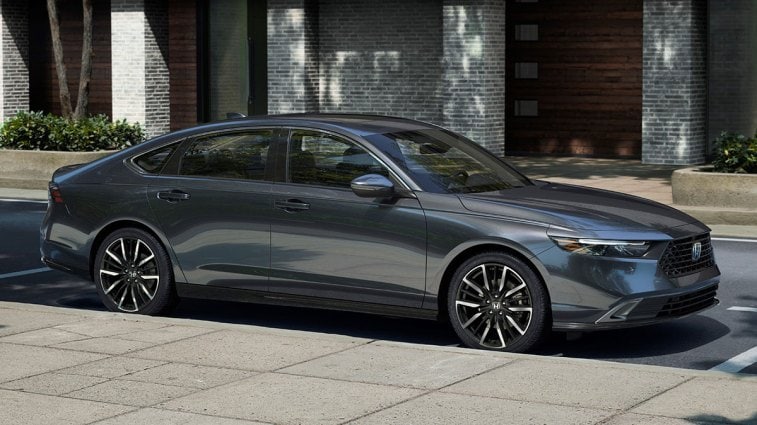
Best Safety Value: $31,005 (EX)
Base Price: $28,990 | Expert Rating: 4.8
Combined Fuel Economy: 32 mpg
Fully redesigned last year, the Accord repeats as our Midsize Car Best Buy for 2024. In addition to its durability and better-than-average resale value, the Accord provides an assortment of safety features and advanced safety technologies. Honda also offers it as a hybrid. It comes with 10 airbags, hill-start assist, auto on-off LED headlights, and high-beam assist. Included among its Honda Sensing suite of safety tech are lane-departure warning, lane-keeping assist, traffic sign recognition, and traffic jam assist. Sadly, blind-spot monitoring and rear cross-traffic alert aren’t available on the entry-level trim. However, they become standard beginning with the EX grade. The Accord earned the IIHS TSP+ rating.
There are other good reasons, like the 48-mpg combined fuel economy, to move up to one of the four top trim levels, but increasing safety features isn’t one of them. Sure, you gain front/rear park assist with the EX-L Hybrid ($35,635). You’ll get a few other of our preferred features, like a head-up display, on the top trim, but the jump in cost doesn’t make sense from a safety standpoint. We’d stop at the EX grade.
See Honda Accord models for sale near you
2024 Hyundai Elantra
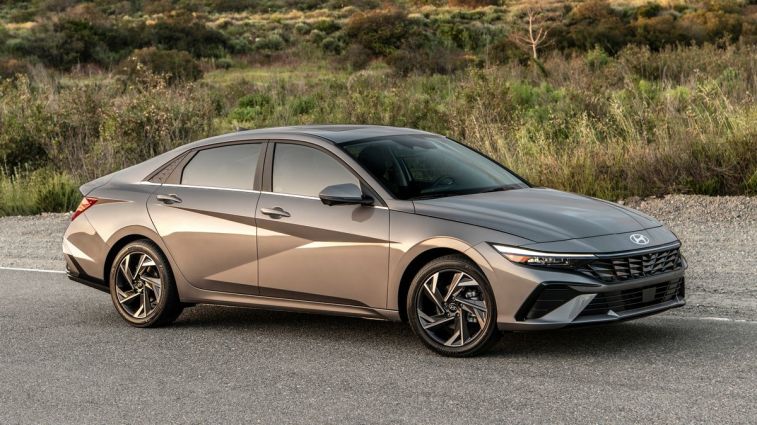
Best Safety Value: $22,775 (SE)
Base Price: $22,775 | Expert Rating: 4.6
Combined Fuel Economy: 36 mpg
For 2024, the Elantra sports a subtle styling refresh and an updated cabin. Its base engine remains a somewhat timid 147-hp 4-cylinder, but the mileage is a healthy 36 mpg in mixed driving. Elantra comes as a hybrid, as well. Space and comfort are hallmarks of the Elantra interior, while safety and value remain solid purchase motivators. Earning the IIHS TSP rating, every Elantra trim comes with automatic emergency braking with pedestrian detection, blind-spot monitoring, rear cross-traffic alert, lane-following assist, lane-keeping assist, safe exit assist, driver monitoring system, and high-beam assist.
Although moving up to the SEL trim doesn’t add any notable safety features, stepping up to the Limited gains you adaptive cruise control, LED headlights, rear park assist with automatic braking, a surround-view camera, and a blind-spot view monitor. Hyundai’s Highway Driving Assist is also included. It allows the Elantra to steer, accelerate, and brake itself under certain conditions. Limited is more than a $5,000 upgrade. At this price point, when safety tech is the deciding factor, we think the SE is the best value.
See Hyundai Elantra models for sale near you
2024 Hyundai Ioniq 6

Best Safety Value: $38,650 (SE Standard Range)
Base Price: $38,650 | Expert Rating: 4.6
Combined Fuel Economy: 135 MPGe
Following the success of the Ioniq 5 SUV, along comes the Ioniq 6 fully electric sedan. Streamlined, with up to 320 hp or 361 miles of range, depending on trim level, and quick charging, the Ioniq 6 is an impressive contender.
This IIHS TSP+ pick comes with a wide range of standard safety features, including FCA with pedestrian and cyclist detection, lane-keeping assist, blind-spot monitoring, safe exit assist, and automatic high beams. If you want blind-spot collision avoidance assist, junction turning assist, or the Highway Driving Assist II semi-autonomous system (HDA I is standard), you’ll have to choose the SEL. The Limited adds a surround-view monitor, blind spot view monitor (camera), and parking collision avoidance assist. If you’re looking for more power, more features, AWD, or more range, we’d recommend some of the higher trim levels. However, there are so many safety features on the base model that the rear-wheel-drive SE Standard Range is the best safety value.
See Hyundai Ioniq 6 models for sale near you
2024 Hyundai Sonata
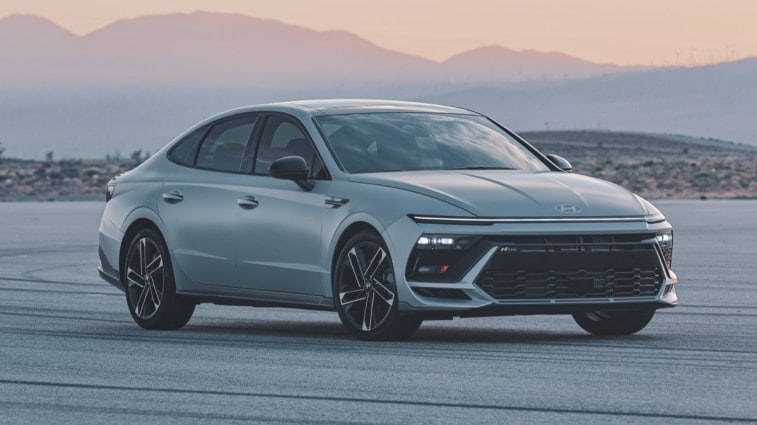
Best Safety Value: $28,650 (SEL)
Base Price: $28,650 | Expert Rating: 4.4
Combined Fuel Economy: 29 mpg
Also available in hybrid trims, the freshened Hyundai Sonata is an IIHS TSP pick. Its 191-hp engine is sufficient for both city treks and highway touring. Also, AWD is now available. We like the Sonata’s value message and passenger-friendly cabin. Its dual 12.3-inch displays remind us of luxury sedans. The Sonata features many of our suggested safety technologies, including automatic emergency braking with pedestrian detection, lane-keeping assist, blind-spot monitoring, rear cross-traffic alert with automatic braking, junction-turning assist, safe exit assist, and adaptive cruise control. LED headlights and taillights, and high-beam assist are also standard.
Stepping up to a higher trim won’t gain any significant additional safety features; consequently, we recommend the SEL.
See Hyundai Sonata models for sale near you
2024 Mazda3
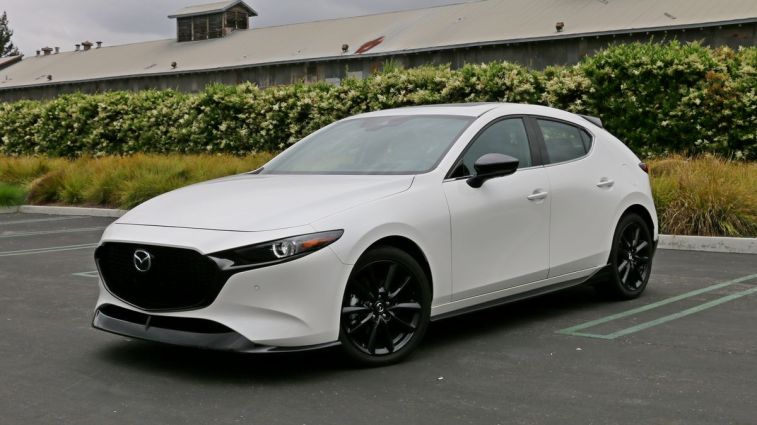
Best Safety Value: $25,355 (Sedan 2.5 S); $26,135 (Hatchback 2.5 S)
Base Price: $25,355/$26,135 | Expert Rating: 4.1
Combined Fuel Economy: 31 mpg
We get excited when a car as much fun to pilot around as the Mazda3 turns out to be one of the safest. Mazda offers the Mazda3 as a sedan or a hatchback in most trims. No matter the body style, the cabin is sporty, and both body configurations boast IIHS TSP+ honors. Above average performance for its class, the Mazda3 sources thrust from a 191-hp 4-cylinder engine. Even in its base 2.5 S trim, it provides many of our sought-after safety features. For example, standard equipment includes automatic emergency braking, lane-departure warning, lane-keeping assist, adaptive cruise control with full stop-and-go, LED headlights, and high-beam assist are standard. So are blind-spot monitoring and rear cross-traffic alert.
Opting for the 2.5 S Premium brings adaptive headlights, a head-up display, and traffic sign recognition. You must move up all the way to the 2.5 Turbo Premium Plus to add a surround-view monitor, front/rear park assist with automatic reverse braking, and Mazda’s Cruising and Traffic Support, a semi-autonomous driving system. We say there are plenty of safety features in the base 2.5 S.
See Mazda3 models for sale near you
2024 Mercedes-Benz C-Class
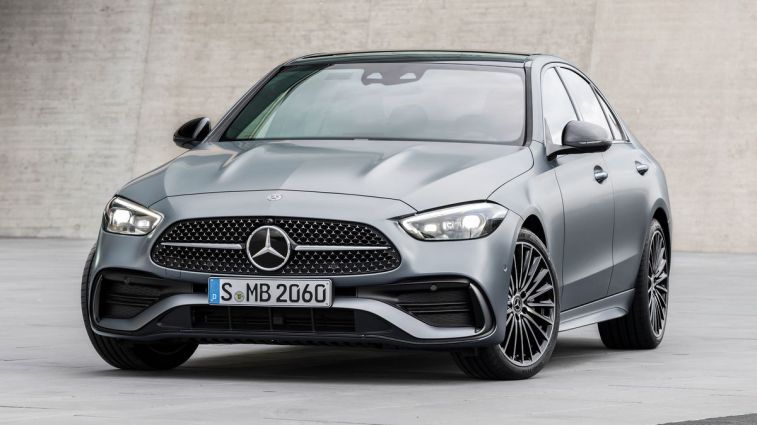
Best Safety Value: $52,100 (C 300 + Driver Assistance Package)
Base Price: $50,150 | Expert Rating: 4.5
Combined Fuel Economy: 30 mpg
Planting the Mercedes-Benz flag in the small, luxury sedan arena, the C-Class provides premium features and solid safety ratings. It is a Top Safety Pick, and NHTSA gave it a 5-Star overall rating. For the price, the entry-level C-Class isn’t exactly packed with advanced safety tech. Among our list of recommended safety features, the entry-level C-Class trim comes with auto on-off LED headlights, high-beam assist, seven airbags, heated outboard mirrors, and rain-sensing wipers. Among the popular advanced safety tech are BSM with exit alert and a driver monitoring system. Also standard is the Mercedes Parktronic with Active Parking Assist, which will find a suitable parking spot and do the parking for you.
To gain other advanced safety tech, like BSM with steering assist, Active Brake Assist with Turning and Cross-Traffic function (junction-turning assist), lane centering assist, lane-keeping assist, and other tech, requires the $1,950 Driver Assistance Package. And that package comes with one of two trims for a bump in price. With the Exclusive Trim package ($2,050) comes a surround-view camera, and several non-safety features; the Pinnacle Trim package ($4,100) adds a HUD, augmented navigation, and LED digital-light headlamps with projections to the Exclusive Trim’s contents. We’d go with the C 300 Exclusive and the Driver Assistance Package.
See Mercedes-Benz C-Class models for sale near you
2024 Subaru Impreza
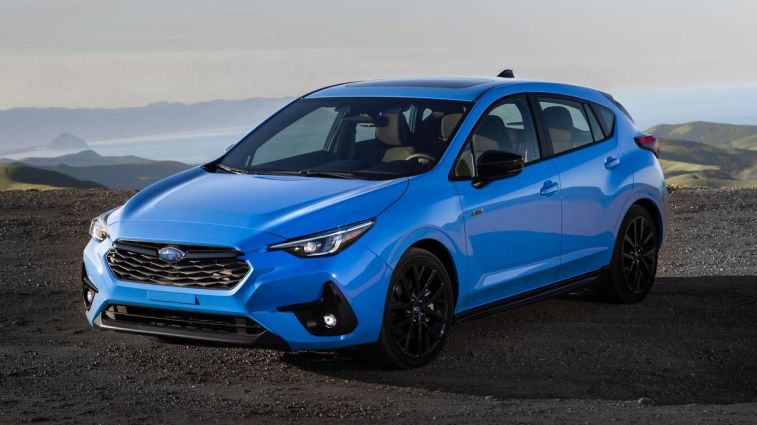
Best Safety Value: $24,115 (Base)
Base Price: $24,115 | Expert Rating: 4.3
Combined Fuel Economy: 30 mpg
Redesigned for 2024, the newest Impreza earned a spot on the IIHS TSP roster. Subaru now offers the Impreza as a hatchback only. More refined than its predecessor, the Impreza provides Symmetrical AWD as standard. Despite its drive, Impreza’s 152-hp 4-cylinder engine delivers an above-average-for-its-class 30 mpg in mixed driving. The entry-level Impreza (simply called Base) includes automatic emergency braking with pedestrian warning, lane departure warning, adaptive cruise control with lane centering, adaptive LED headlights, and high-beam assist.
Spending the $2,000 to move up to the Sport gains a lot of goodies like an 11.6-inch touchscreen but no additional safety features. However, it is the gateway to an option package with blind-spot monitoring with lane-change assist and rear cross-traffic alert. That adds another $2,000 to the price. Although we’d move up to the Sport trim, it would be for all the other extras and not the access for the option package. As far as safety goes, the Base is the best value.
See Subaru Impreza models for sale
2024/2025 Toyota Camry
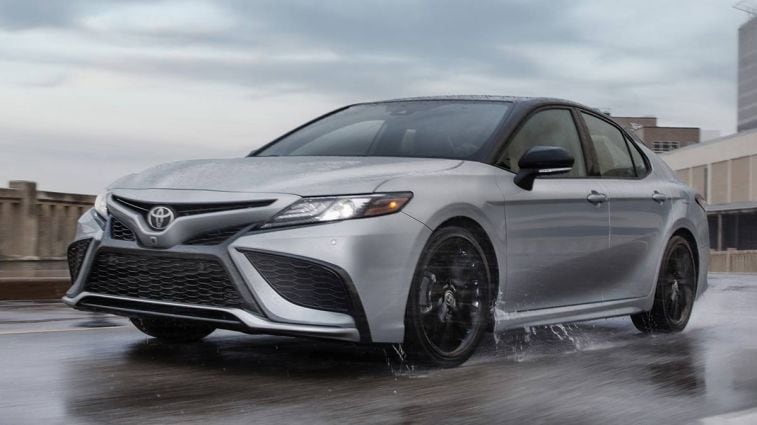
Best Safety Value: $28,795 (LE + BSM with options)
Base Price: $27,515 | Expert Rating: 4.6
Combined Fuel Economy: 32 mpg
Few sedans in history have achieved the success and positive reputation of the Toyota Camry. It checks all the boxes as a family hauler. Comfortable, safe, fuel-efficient, and reliable, the 2024 Camry is a Top Safety Pick and comes standard with Toyota’s Safety Sense 2.5+. It contains LKA, LDW with steering assist, ACC, and LTA. Also standard are 10 airbags and high-beam assist. Not only are LED headlights standard but LED taillights and LED daytime running lights are as well.
You can stick with the base LE and add the Blind Spot Monitor with options package, a $1,280 bundle that includes BSM, RCTA, and an auto-dimming rearview mirror, along with a convenience goodie or two. We recommend that combination as your best safety value.
In addition, we want to highlight the all-new 2025 Toyota Camry, which has even more standard safety features than the 2024 and is already on sale. It’s comfortable, safe, fuel-efficient, and reliable. Every 2025 Camry is a hybrid and comes with Toyota’s Safety Sense 3.0. This bundle of advanced tech includes AEB, adaptive cruise control, lane departure alert with steering assist, and Lane Tracing Assist. It also has, as standard, Toyota’s Proactive Driving Assist, which helps the driver slow the Camry and steer through curves. High-beam assist, safe exit assist, blind-spot monitoring, and rear cross-traffic alert are also included. The airbag count is 10.
As far as safety is concerned, you can stick with the entry-level LE for $29,495. A head-up display and a surround-view camera are options on the two highest trim levels. Neither the IIHS nor NHTSA have crash-tested the new Camry. However, we are sufficiently confident it will score high marks with both and qualify for this list.
See Toyota Camry models for sale near you
2024 Toyota Crown
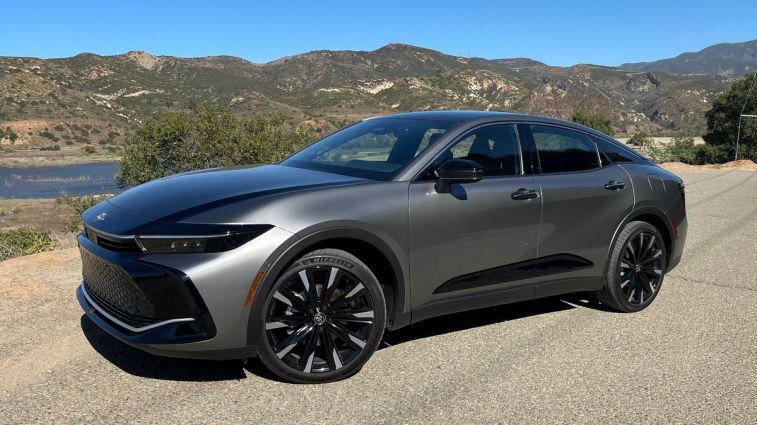
Best Safety Value: $41,445 (XLE)
Base Price: $41,445 | Expert Rating: 4.4
Combined Fuel Economy: 41 mpg
The Toyota Crown may be the answer to a question that no one was asking, but the result is a stunningly good-looking hybrid sedan with unusually high ground clearance and AWD. Before it launched, there was some confusion as to whether the Crown was a sedan or a crossover. Sedan seems to be the answer; in any case, we like it. The 236-hp hybrid system, found in the two lower trims, delivers an estimated 41 mpg in mixed driving. The IIHS gave the Crown a nod of approval, placing it on the TSP list.
Standard safety features include LED projector headlights, high-beam assist, automatic emergency braking with pedestrian detection, traffic sign recognition, blind-spot monitoring, rear cross-traffic alert, junction-turning assist, lane-keeping assist, lane departure warning with steering assist, and adaptive cruise control. Also standard is Proactive Driving Assist, which anticipates curves, providing gentle braking and steering support. Stepping up to the Limited trim adds rain-sensing wipers, while the range-topping Platinum grade gains a surround-view camera and self-parking system. We’d save the extra money and stay with the entry-level XLE trim.
See Toyota Crown models for sale near you
2024 Toyota Prius
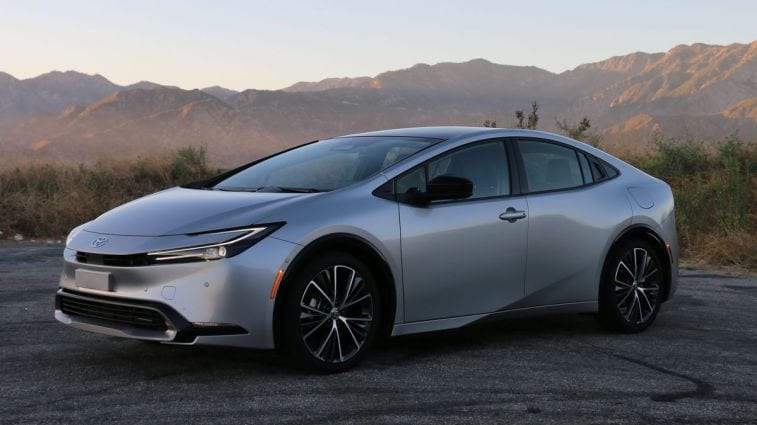
Best Safety Value: $29,045 (LE)
Base Price: $29,045 | Expert Rating: 4.8
Combined Fuel Economy: 57 mpg
With sleek styling, significantly more power, and better combined mpg, the Toyota Prius has been making waves since its 2023 redesign. In addition to offering stellar fuel economy, the Prius comes standard with plenty of impressive safety features. Even the base model, the LE, has Toyota Safety Sense 3.0. This suite of safety features includes forward collision warning with pedestrian detection, automatic emergency braking, lane-departure warning with steering assist, adaptive cruise control, lane-keeping assist, road sign recognition, and automatic high beams. In addition to detecting pedestrians, Toyota Safety Sense 3.0 can detect bicycles and motorcycles. Its Emergency Driving Stop can determine when the driver may have a medical issue and can bring the Prius to a stop.
The Prius also comes standard with blind-spot monitoring with rear cross-traffic detection, safe exit assist, and tire pressure monitoring. You can add front and rear parking sensors for $35, and AWD for $1,400, but you have just about every safety feature you need in the LE. The IIHS rates the Prius as a TSP+.
See Toyota Prius models for sale near you
2024 Toyota Prius Prime
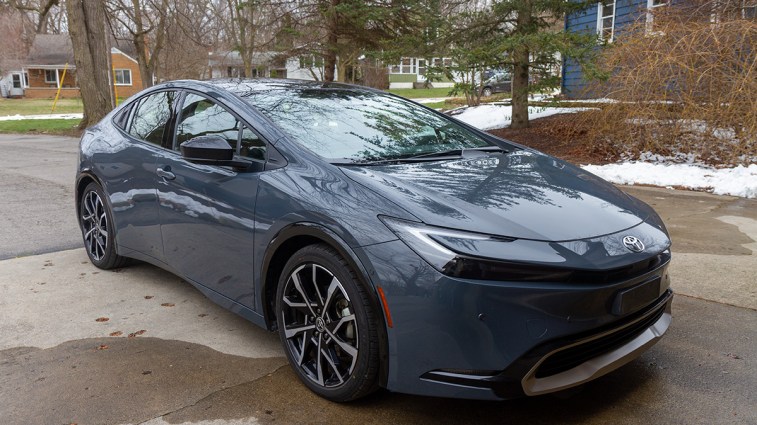
Best Safety Value: $34,070 (SE)
Base Price: $34,070 | Expert Rating: 4.8
Combined Fuel Economy: 127 MPGe, 52 mpg
The Prius Prime is the plug-in hybrid version of the Prius and offers up to 44 miles of electric-only range. Horsepower is up by nearly 100, for a total of 220 system horsepower. That makes the Prius Prime more fun to drive, too. We like it so much that we named it the Best New Model among our 2024 Best Buy Awards. Moreover, the American Council for an Energy-Efficient Economy (ACEEE) called it the greenest car on the market in 2024.
As with the Prius, all trim levels of the Prius Prime come with Toyota Safety Sense 3.0. That means you get adaptive cruise control, lane-departure warning with steering assist, forward collision warning with pedestrian detection, automatic emergency braking, lane-keeping assist, road sign recognition, and automatic high beams. All trim levels also come with blind-spot monitoring with rear cross-traffic alert, safe exit assist, and eight airbags. The Prime is not available with AWD. Because the Prius Prime is so well-equipped at every trim level, we recommend getting the base SE for the best safety value. The Prius Prime is a Top Safety Pick.
See Toyota Prius Prime models for sale near you
IIHS TSP+ Award Winners
| MAKE AND MODEL | IIHS | NHTSA |
| 2024 Acura Integra | TSP+ | 5 Stars |
| 2024 Genesis Electrified G80 | TSP+ | 5 Stars |
| 2024 Genesis G80 | TSP+ | 5 Stars |
| 2024 Genesis G90 | TSP+ | Not Rated |
| 2024 Honda Accord | TSP+ | 5 Stars |
| 2024 Hyundai Ioniq 6 | TSP+ | Not Rated |
| 2024 Mazda3 sedan and hatchback | TSP+ | 5 Stars |
| 2024 Toyota Prius | TSP+ | 5 Stars |
IIHS TSP Award Winners
| MAKE AND MODEL | IIHS | NHTSA |
| 2024 BMW 5 Series | TSP | 5 Stars |
| 2024 Hyundai Elantra | TSP | 5 Stars |
| 2024 Hyundai Sonata | TSP | Not Rated |
| 2024 Mercedes-Benz C-Class | TSP | 5 Stars |
| 2024 Subaru Impreza | TSP | 5 Stars |
| 2024 Toyota Camry | TSP | 5 Stars |
| 2024 Toyota Crown | TSP | 5 Stars |
| 2024 Toyota Prius Prime | TSP | 5 Stars |

